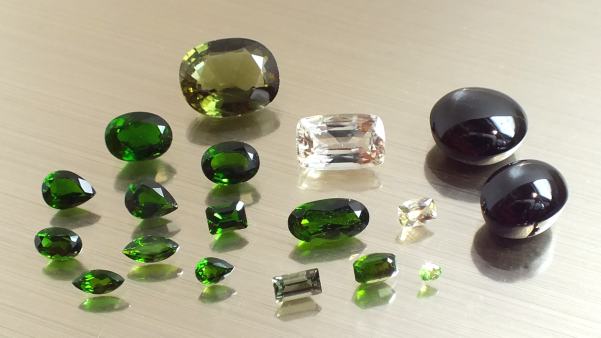 |
| 様々な透輝石 0.11ct -16.8ct |
透輝石(Diopside)
 |
| 様々な透輝石 0.11ct -16.8ct |
| 化学組成 (Composition) |
結晶系 (Crystal system) |
結晶形 (Crystal form) |
モース硬度 (Hardness) |
比重 (Density) |
屈折率 (Refractive Index) |
副屈折 (Birefringence) | |
| CaMg(Si2O6) | 単斜晶系 (Monoclinic) |
6 - 7 | 3.2-6 | 1.66-72 | 0.026 | ||
鉱物名の由来 (About name and occurence)
ダイオプサイドの名は1806年,フランスの鉱物学者アウイ(Haüy)による命名です。
ギリシア語の ”Dis=二つ、とOpsis=視る”に由来する名前です。
”二つ見る”とはどういうことなのか考えてみました。
資料では副屈折値が高く結晶を通して画像が二重に見えるためとあります。
確かに透輝石の副屈折は0.026と多くの鉱物の中では高い方です。
しかし橄欖石の0.036、緑簾石(エピドート)の0.039、ダトー石の0.044、ベニト石の0.047、ジルコンの0.059、スフェーンの0.134、方解石の0.172等、もっと大きな価を示す鉱物があります。
が、方解石を除いてはそれらの鉱物には結晶を通して画像が見えるような透明な結晶は非常に稀です。
一方透輝石は当時でもアルプス山脈に透明な結晶が豊富に発見されました。
恐らくアウイはダイオプサイドの単斜晶系の柱状の透明な結晶を本の上にでも置いたのでしょう。
そして結晶を通して文字や線が二重に見えることに気づいたのではないかと思います。
アフガニスタン産の透明な結晶を通して線が二重に見える写真を撮って見ました。
方解石ほどには副屈折の価が大きくないために一つの結晶面で画像が二つ見えるわけではなく、柱状の二つの面を通った線が二重に見えます。"Diopside" derives it's name from Greek "dis=dual and Opsis=see" named by French mineralogist J.B. Haüy in 1806.
Certainly, doubling might be visible through transparent diopside crystal because of high birefringence, which is, however, not too high as other common minerals, such as Peridote(0.036), Epidote(0.039), Datolite(0.044), Benitoite(0.047), Zircon(0.059), Sphene(0.134) and Calcite(0.172).
Why did Haüy name Diopside with relatively intermediate birefringence ?
Except Calcite, other common minerals with high birefringence are rarely transparent to show visible doubling effect, while transparent Diopside is relatively common from Alps. Pbobably Haüy might have put a Dioside crystal on a book to recognize the clear doubling of printed character.和名は珍しく美しい名がついています。造岩鉱物としては稀なことですが、透明な美しい結晶が日本でも採れるためでしょう。
透輝石はカルシウム成分に富む大理石のような接触変成岩のスカルン地帯、また輝石片麻岩、斑糲岩、橄欖岩、輝緑岩等のような塩基性、超塩基性の半深成岩や深成岩中、ペグマタイトや熱水鉱床、更に隕石中と広範に発見されます。Dioside is recovered together with Augite and Hedenbergite, the most important ferromagnesian mineral of igneous rocks, abundant in basic and ultrabasic rocks, characteristic of gabbros and baslts. Dioside especially occurs in medium-and high-grade metamorphosed dolomitic limestones and skarns.
透輝石は輝石属に属し、他の輝石属の鉱物との固溶体として産出することがあります。
例えば中米では翡翠(硬玉)に10%程度透輝石成分が混入している場合があり、Mayaiteと呼ばれます。
透輝石が鉄分を20%以上含むと暗緑、濃褐色の灰鉄輝石(Hedenbergite)となります。
マンガンや亜鉛の変成鉱床に産する透輝石のカルシウムとマグネシウム成分の大半がマンガンに置換された透輝石の変種はヨハンソン輝石(Johannsenite)と呼ばれ、アメリカ、ニュージャージーのフランクリン鉱山ではかつて25cmもの結晶を産しました。
イタリアアルプス、ファッサ渓谷特産の透輝石はファッサ輝石と呼ばれます。
これは変種ではなく、柱状結晶が金米糖のように放射状に集合した特異な産状による命名と思われます。
透輝石の透明な美しい結晶は世界各地の山岳性の熱水鉱脈に多く発見されます。
しかし陰りを帯びた淡緑色のルースは宝石としては魅力がありませんから、もっぱらコレクター用にカットされるのみです。Dioside is a member of pyroxen group and is often found as solid solution with other pyroxen ; ex. In Central America, 10% of Diopside is contained in Jade and is called Mayaite. 20% of ferric rich diopside is dark green-brown Hedenbergite. When most of diopside' calcium and magnesium elements are replaced by manganese is Johannsenite, which 25cm long crystal was onece found at Frankline mine, New Jersey, U.S.A.. In Fassa valley, Italy, fine prismatic crystals, radiating like confetti candy form is called Fassaite. Although transparent, gemmy diopside crystal is abundant in hydrothermal vein, due to dark green color, it is rerely facetted for gemstone.
宝石質の透輝石 (Gemmy diopside)
最大のクロム透輝石 25.33ct 22.1x16.0mm 3.32ct 10.6x8.0mm 2.08ct 9.2x7.0mm 0.62ct 6.1x5.9mm Inagli, Yakutia, Russia
1.12ct
8.3x6.1mm1.32ct
8.4x6.2mm0.90ct 0.47ct 2.54ct 11.6x8.0mm 1.0ct 6.4x4.4mm 0.32ct 0.59ct Inagli, Yakutia, Russia Urçuai, Brazil
10.59ct 16.2x13.4mm 5.45ct 5.44ct 14.0x8.7mm 0.74ct 6.8x3.8mm 0.50ct 6.0x4.0mm Mogok, Burma Pakistan ? Cranberry Lake, Ontario, Canada
ヴァナジウム発色の透輝石 (Vanadium Diopside) 16.8ct
15.7x14.6mm14.5ct
13.8x11.2mm1.18ct 0.11ct Ø3.52x2.09mm Lelatema Hills, Tanzania Southern India 宝石用途としてカットされるのは最大で2%程度のクロムを含むクロム・ダイオプサイドで主に銅とクロムを含む変成鉱床脈に発見されます。
宝石質のクロム・ダイオプサイドはしかし、かつてはケニアとフィンランドからほんの少し産出するだけの大変稀で、したがってとても高価な、宝石収集家垂涎の宝石でした。ところが1987年にロシアで大きな鉱脈が発見されると、1990年代初頭からアメリカで高価なツァヴォライト・ガーネットやクロム・トルマリンの代用品として、テレビ・ショッピング用に量販されるようになりました。
クロム・ダイオプサイドの色はやや翳りを帯びた魅力的な濃い緑で、宝飾品にすると最上級のエメラルドのように見えます。
大量に採れるためにツァボライトと比べれば百分の一、クロム・トルマリンと比べても十分の一程のカラット当たり、20〜50ドル程度の値段で一気に大衆的な宝石となりました。
ただし、モース硬度がやや低いこと、劈開しやすく研磨中に欠けやすいので原石からの歩留まりが6%と極めて低いためにルースの大きさは平均して1カラット前後と小さいのが難点です。
10カラットを超えるような大きなルースは滅多にありません。
稀にあったとしても余りにも色が暗く魅力的ではありません。
近年ブラジルのウルスアイからも石英中にクロムダイオプサイドの見事な結晶が採れるようになったため、今後は透明度の高い大きなルースがカットされる可能性があります。
また、南インドから採れる黒いダイオプサイドはカボションに磨くと十字のスターを見せます。
バブル時代の日本ではブラック・スター・サファイアと偽って法外な値段で売りつけた悪徳業者も出現しましたが、サファイアのスターは6本ですから容易に見分けがつきます。
ブラック・スター・サファイアもそれほど高価な石ではありませんが、スター・ダイオプサイドならカラット当たり1〜2ドル,あるいは1個当たり数百円からせいぜい3000円くらいともっとも安価な宝石の一つです。
Only emerald green chorme diopside, which contains maximum 2% of chrome, found in cupper and chrome containning metamorphic zone has been facetted as gem stone. But in the past, a few gem chrome diopside crystal was mined in Kenya and in Finnland, therefore it was extremely rare and expensive, limited only for gem collecters.
In 1987、a huge deposit was found in Siberia, Russia then a mass sales on TV-shopping started in the U.S.A. as moderate priced replacements of expensive Tsavorite and Chorome Tourmaline.
Chorome Diopside is a little dark shaded green and looks like the highest quality emerald when setted in the jewelry.
Thanks to abundant supply, today price has dropped to affordable level of US$20〜50/carrat , which is one hundredth of Tsavorite garnet and one tenth of Chrome Tourmaline. Disadvantages of chrome diopside as gemstone are ; low hardness, most of faceted stone does not exceed one carat, because of yield rate as low as only 6%, due to the perfect cleavage. A loose over 10 carrat is quite rare and often too dark.. However a new find of big transparent gem crystal from Urçuai, Brazil is expected to supply bigger gemstones.
Southern India is an abundant producer of low cost black star diopside, which is often offered as black star sapphire. Be careful !
 |
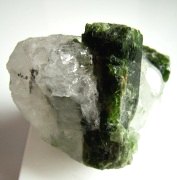 |
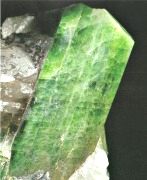 |
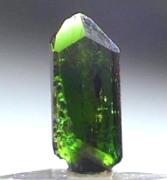 |
 |
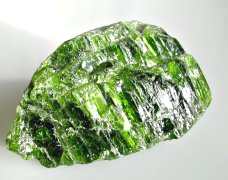 | ||
| 名前の由来 二重に見える線 Afghanistan |
Chrome Diopside 35mm Urçuai, Brasil |
Chrome Diopside 41mm Outokumpu, Finland |
Chrome Diopside 16mm Tormiq, Baltistan Pakistan |
Diopside
7cm Tyrol, Austria |
Chrome Diopside rough
48mm Inagli, Yakutia, Russia | ||
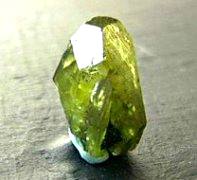 |
 |
 |
 |
| Diopside, 24mm
Kotel Khybar Pass, Pakistan |
Diopside 10mm Nordmarken, Sweden |
マンガン透輝石(Mangano Diopside)
110mm Costi, Val Malenco, Italia |
Diopside 4mm Pizzo Tremogge Val Malenco、 Italia |
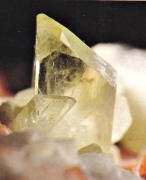 |
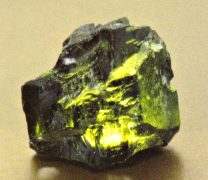 |
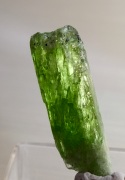 |
 |
 |
| Alalite 1cm Val d'Ala Italia |
透輝石結晶 63ct 26x26x15mm Gemmy diopside crystal Merelani Hills,Tanzania |
ヴァナジウム透輝石 (Vqanadium Diopside) 23x7x4mm Lelatama Hills, Tanzania |
菫青輝石(Violane) 2.5x2x1.5cm Val d'Aosta Italia |
透輝石 (Diopside) China |
透輝石の色
透輝石には色合いにより様々な名前があります (Diopised has various color variations) ;
アラライト(Alalite,Alaite) : イタリアのアラ渓谷(Val d'Ala)産に代表されるほぼ純粋な成分の無色透明
Pure, Tranparent specimen, reported from Val d'Ala, Italy.マラコライト(Malacolite) : 一般的な透輝石の色合いで二価の鉄イオンにより淡黄緑色を帯びている
Common Dioside with pale greenish-yellow, colored by di-valent ferric ion.クロムダイオプサイド
(Chorome diopside): 最大で2%のクロムを含みやや翳りを帯びたエメラルドグリーンを示す。
Dark emerald-green specimen, colored by maximum 2% of chrome (and or Vanadium) ion.マンガン透輝石
(Mangano Diopside): 微量のマンガンを含み淡紫色を示す。
(Mauve colored specimen colored by manganese.菫青輝石(Violane) : ピエモンテ地方、アオスタ渓谷,マレンコ渓谷入り口のキエサ(Chiesa)の町
の蛇紋岩採掘場やシッソーネ渓谷等,主にイタリア・アルプス特産で濃い菫色を帯びた種類。
イタリア語ではヴィオラーネと呼ばれ、塊状のものを薄く切断し研磨して装飾用途に古くから使われていた。
Violetish spcimen found at northern Italy(Val d'Aosta and Val Malenco).
Thin sliced plate has been used for ornamental purpose.